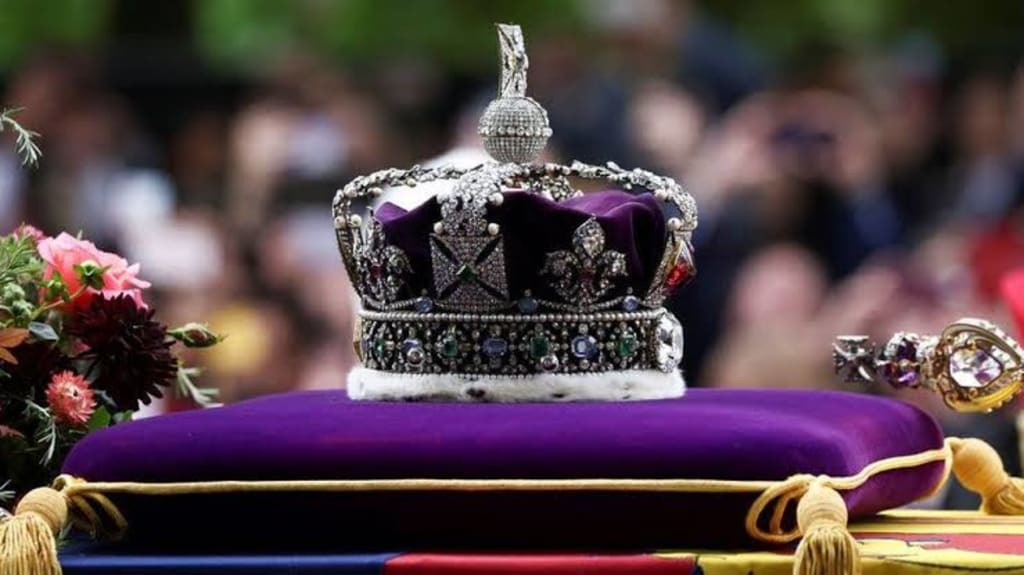
Crown of Queen Elizabeth
The Imperial State Crown is made of an openwork gold frame with three very large stones mounted on it. There are also 268 pearls, 17 sapphires, 11 emeralds, and 11 rose-cut diamonds among the coloured stones set in gold mounts along with 2868 diamonds in silver mounts.
The huge Cullinan II brilliant, which is the second-largest stone cut from the Cullianan Diamond, is located at the front of the crown band (also known as the Second Star of Africa). The huge oval sapphire known as the "Stuart Sapphire" is located at the back of the ring. An openwork frieze that spans two rows of pearls and has eight step-cut emeralds and eight sapphires connects the two enormous stones.
Each of the arches has two pearl acorns in diamond cups protruding from the side and is cast as an oak leaf. The arches are set with diamonds. The "Queen Elizabeth's Earrings"—four enormous pear-shaped pearls with rose-diamond caps—hang from the intersection of the arches. A monde of fretted silver that is pavé-set with brilliants and has a cross-pattée above it that is set in the centre with an octagonal rose-cut sapphire called as "St. Edward's Sapphire" tops off the arches.
The cap and band of the Crown are made of purple velvet. The "Black Prince's Ruby" and the "Stuart Sapphire" have small plates on the back that are inscribed with information on the history of the Crown.
The king exchanges the Imperial State Crown, also known as the Crown of State, for St. Edward's Crown at the conclusion of the coronation ritual. The traditional coronation crown was always maintained at Westminster Abbey until the American Civil War, and the king needed a different crown to wear upon leaving the Abbey. For official occasions, like as the yearly State Opening of Parliament, the Imperial State Crown is also worn. The phrase "imperial state crown" first appeared in the fifteenth century, when English kings adopted a crown shape enclosed by arches to signify that their country was independent of all other heavenly powers.
This crown was created in 1937 for King George VI's coronation, but it is quite similar to one created for Queen Elizabeth
Rundell, Bridge & Rundell, the era's royal jewellers, created a portrait of Queen Victoria in 1838. Many ancient stones with a variety of legends attached are set on the crown. They consist of:
One of the last Anglo-Saxon monarchs of England, Edward the Confessor (1042–66), or St. Edward, is said to have been solicited for charity by a beggar, according to the narrative associated with St. Edward's sapphire. The King gave the beggar a ring despite not having any money on him. In response to the King's assistance, the beggar later revealed himself to be St. John the Evangelist, who helped two English pilgrims in Syria and requested that they give St. Edward the ring back. In 1066, the King was interred alongside the ring at Westminster Abbey.
The seven pearls that Catherine de Medici received from Pope Clement VII upon her marriage to Henri II of France in 1533 have come to be known as Queen Elizabeth's Earrings, the four huge pearls in them. After giving them to her daughter-in-law Mary, Queen of Scots, she purportedly sold them to Elizabeth I following her imprisonment. Despite this romantic tale, it appears that at least two of the pearls did not enter the Collection until the nineteenth century. Elizabeth was unlikely to have worn them as earrings because she preferred to wear pearls scattered over her ruff, in her hair, or on her costume.
Tradition has it that the ruby given to Edward, Prince of Wales, was known as "The Black Prince's Ruby," which was actually a sizable spinel. The 170 carat stone was drilled in the past to be used as a pendant and is of Eastern provenance. According to legend, it was taken by Don Pedro from the Moorish monarch of Granada and transported to Spain in 1366. It was one of the stones Henry V wore in his helmet during the Battle of Agincourt in 1415. It is challenging to demonstrate that this is the same stone, but a sizable Balas (or spinel) is undoubtedly mentioned in descriptions of old state thrones, and it has been reset each time the crown has been reshaped.
The Stuart Sapphire weighs about 104 carats and has already been drilled for use as a pendant. Traditionally, it has been assumed that James II sneaked it out of England in December 1688. The Old Pretender, his son Prince James Francis Edward, received it from him, and Henry, Cardinal York eventually acquired it. After the Cardinal's passing, George IV dispatched Italian dealer Angioli Bonelli to locate any remaining Stuart papers. He came across a Venetian merchant who produced a sizable sapphire and claimed it belonged to the Stuart Crown. The sapphire was bought by Bonelli and sent back to Britain. By the time of Queen Victoria's coronation, it had been placed into the front of the band of her State Crown, and George IV was certain that it was the Stuart Sapphire.
The "Second Star of Africa," also known as Cullinan II, has a 317.4 carat weight. From the enormous Cullinan Diamond, the biggest diamond ever found, it is the second-largest stone to have been cut. Frederick G.S. Wells discovered it in 1905 in the Premier Mine, some 20 miles outside of Pretoria, South Africa. The 3025-carat stone bears Thomas Cullinan's name, who is the chairman of the Premier (Transvaal) Diamond Mining Company. The diamond was given to Edward VII in 1907 as a symbolic act of reconciliation to mend the wounds caused by the Boer War between Britain and South Africa. On November 9, 1907, the King's birthday, it was solemnly presented to him at Sandringham. Amsterdam-based Asschers carved the stone. Nine substantial stones were extracted. Amsterdam-based Asschers carved the stone. The original diamond was cut into nine sizable stones. Three men worked on the cutting and polishing for eight months. In addition, 97 other minor brilliants as well as several unpolished bits were produced. The Sovereign's Sceptre was fitted with the stone's greatest cleaving, Cullinan I, the Star of Africa, and the Imperial State Crown's front band was fitted with Cullinan II. The last of the numbered stones were set in jewellery (and do not form part of the official Crown Jewels).
Provenance
Commissioned for the Coronation of King George VI on 12 May 1937, from the Crown Jewellers, Garrard & Co.
Personas invovled
Creator(s)
Garrard and Co. (jeweller)
Designer and manufacturer Rundell Bridge & Rundell
King George VI, King of the United Kingdom, is the acquirer (1895-1952)





Comments
There are no comments for this story
Be the first to respond and start the conversation.